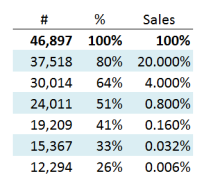Some months ago, I read a piece praising Procter&Gamble for having finally adopted the “new standard” of paying suppliers in 90-100 days rather than the “old” 45 days [1]. This new standard comes from using “Reverse Factoring”, a financing approach that became popular in Spain in the 80’s and 90’s (oddly enough, the “Spanish” name for reverse factoring is “confirming”, a registered name by Banco Santander). The scheme has spread since 2008, to many other countries, especially in Northern Europe.
How reverse factoring (RF) works
Consider a strong buyer (say with rating AA) that buys on account from its weak suppliers (say with rating BBB), and pays them in 40 days. Suppliers in need of liquidity sell some of the buyer’s receivables to a financial institution at a high cost, say 15%. The cost is high because 1) the bank protects himself against the risk of the buyer not paying the supplier and 2) the supplier is weak so he may not be able to repay the bank if the buyer doesn’t pay him.
Now the buyer, in conjunction with her bank, proposes the supplier the following: “Whenever you need liquidity, you can sell my receivables to the new bank, which will charge you a mere 6% rather than 15%. In return, I will pay you in 80 days rather than 40.” The bank is willing to charge only 6% because it has the commitment from the buyer that she will pay at due date–recall the buyer is financially strong. The supplier is better off because, even if he is paid later, the lower cost of the factoring contract more than makes up for it. The buyer is better off as well because she pays 40 days later to the supplier, freeing up a nice pile of cash. Therefore, reverse factoring (the scheme just described) seems to be a win-win-win solution. That may be the reason why some European governments, such as Mr. Cameron’s in the UK last year, have seen in this scheme a potential solution for the liquidity problems of many private SME companies, thus they are encouraging firms and financial institutions to adopt RF programs. Others, as the Dutch government, might follow suit.

source: http://www.metrotrader.net
Where the problem stems from
The scheme works beautifully as long as the buyer pays on time, which is expected, since it is a relatively financially strong player. However, what if the buyer cannot duly pay for her invoices? Banks may immediately opt out of the corresponding RF program, which may well drag weak suppliers into bankruptcy. This may affect an entire industry, and even a major portion of an economy. In fact, if these RF practices generalize, they may well become the seed of the next financial crisis.
You may be right to think that odds are not high that a strong player cannot pay her suppliers on time. But it does not mean that it is impossible. For instance, Moody’s, Standard & Poor’s, and Fitch Ratings of Lehman Brothers was A or above when the latter went bankrupt in Sep 2008. Similarly, 75% of the analysts covering Parmalat had a buy or neutral rating on the stock a quarter before it collapsed in 2003. OF course these two corporations went bankrupt because of a financial scandal, but it is a fact that financial scandals do occur.
How to prevent RF from growing exponentially
Although RF programs may be beneficial under some circumstances, its generalised use may lead to serious situations. One way to prevent these programs from growing too much would be for factors (the financial institutions that provide liquidity) to put a risk premium on buyers, so as to compensate the negative outcome if they collapse. Additionally, suppliers should be aware of the risks of joining these RF programs before it is too late.
References
[1] http://www.scdigest.com/ONTARGET/13-05-02-1.PHP?cid=7006










